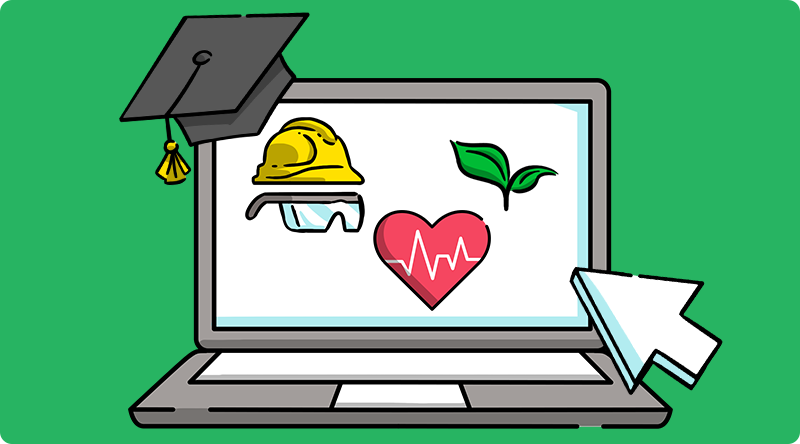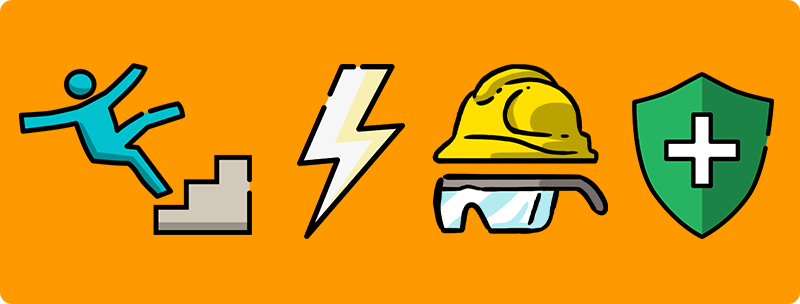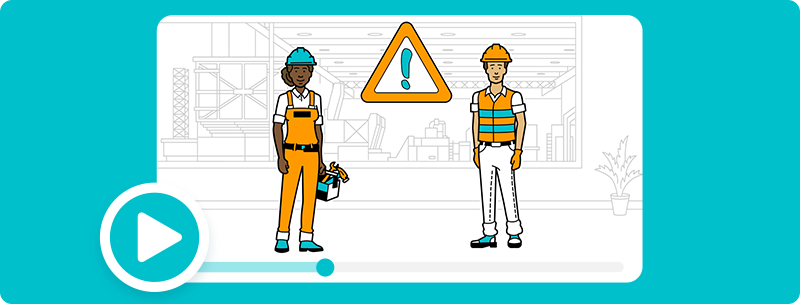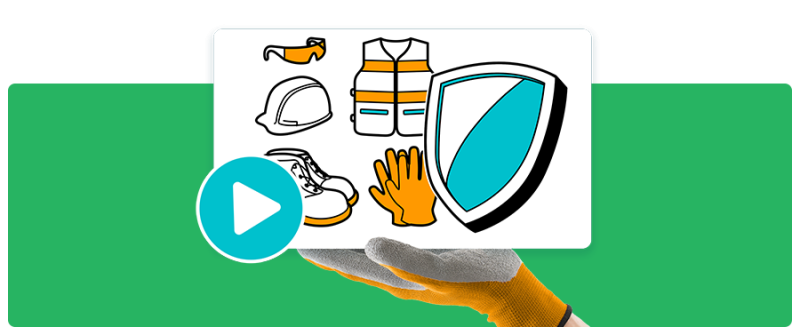How Environment, Health & Safety training and education can help improve workplace safety
Written by Tim Moss | 5th September 2023

Organizations that value workplace safety also value their employees. The numbers speak for themselves: 81% of employees say that physical safety is very important to them. So how can we ensure that safety becomes a habit? Effective training and education are key to building a competent and safety-conscious workforce.
In this article, we will look at the basics of EHS (Environment, Health & Safety) training and highlight the importance of visual learning methods. Beyond compliance, we will also explore specialized training programs for high-risk tasks and industry-specific hazards.
Technological advances have opened up new possibilities for EHS training, with e-learning and virtual reality offering scalable and engaging training experiences. We will also explore the exciting role of generative AI in EHS communication and training.
Finally, we’ll look at measuring the effectiveness of training that drives safety goals and enables continuous improvement. Let’s dive in and discover how education and training provide the foundation for a safe and skilled EHS workplace while modern methods and technologies optimize this process.
In this article, we will look at the basics of EHS (Environment, Health & Safety) training and highlight the importance of visual learning methods. Beyond compliance, we will also explore specialized training programs for high-risk tasks and industry-specific hazards.
Technological advances have opened up new possibilities for EHS training, with e-learning and virtual reality offering scalable and engaging training experiences. We will also explore the exciting role of generative AI in EHS communication and training.
Finally, we’ll look at measuring the effectiveness of training that drives safety goals and enables continuous improvement. Let’s dive in and discover how education and training provide the foundation for a safe and skilled EHS workplace while modern methods and technologies optimize this process.

EHS training basics: Building a strong safety foundation
EHS training isn’t just about following the rules – it’s a key part of creating a culture where safety matters. Investing in good safety training doesn’t just reduce accidents; it makes the workplace a better place. In fact, 46% of employees consider safety when deciding whether to continue working for a company. (Employee Safety Report 2023)
These trainings go far beyond simply imparting knowledge. They are key to raising employee awareness of safety-related policies, procedures, and best practices. This awareness is critical to minimizing risks, preventing accidents, and identifying health hazards in the workplace.
EHS training provides the foundation for employees to base their behaviors and decisions on company values and the highest safety standards. This basic training lays the foundation for a workplace culture where safety is a priority, ensuring employee well-being and business productivity.
But what does effective EHS training look like? What methods and content are most effective? The following sections explore these questions and examine the importance of EHS training in building a solid safety foundation.
These trainings go far beyond simply imparting knowledge. They are key to raising employee awareness of safety-related policies, procedures, and best practices. This awareness is critical to minimizing risks, preventing accidents, and identifying health hazards in the workplace.
EHS training provides the foundation for employees to base their behaviors and decisions on company values and the highest safety standards. This basic training lays the foundation for a workplace culture where safety is a priority, ensuring employee well-being and business productivity.
But what does effective EHS training look like? What methods and content are most effective? The following sections explore these questions and examine the importance of EHS training in building a solid safety foundation.

Visual learning methods for effective knowledge transfer
Visual learning methods are an effective way to convey EHS knowledge. These topics can be complex, but visual elements such as video, graphics, and interactive content make it easier to absorb and understand. Consider the following methods for EHS training:
- Storytelling creates an emotional connection to safety issues. Empathy and engagement are naturally triggered when employees witness relatable characters navigating hazardous situations and making informed decisions. This emotional connection compels employees to internalize the importance of safety practices, fostering a sense of personal responsibility for their own well-being and that of their colleagues.
- Interactive content such as quizzes or case studies actively engages learners. They allow employees to apply and test what they have learned, deepening understanding and making learning more interactive and fun.
Combining these visual learning methods can help make EHS content more accessible and engaging. Not only do they support learning, but they also promote recall and application of learning in real-world work environments creating a sustainable safety culture.

Specialized training programs for risk areas and industry-specific hazards
While general EHS training covers the basics, it is important to address specific needs. Higher-risk work areas or industry-specific hazards require customized training programs beyond general guidelines.
One example is training for workers in the construction industry, where potential hazards are of particular concern. Explainer videos can walk workers through step-by-step safety procedures, illustrating the correct usage of protective equipment, safe operating techniques, and emergency protocols. This ensures that workers are well-prepared before they step onto the construction site.
One example is training for workers in the construction industry, where potential hazards are of particular concern. Explainer videos can walk workers through step-by-step safety procedures, illustrating the correct usage of protective equipment, safe operating techniques, and emergency protocols. This ensures that workers are well-prepared before they step onto the construction site.
- Fall Prevention and Protection: Show videos on the proper use of fall protection equipment and safe techniques for working at heights, providing clear visual guidance for workers.
- Electrical Safety: Use videos to illustrate electrical safety principles, highlighting potential hazards and best practices for staying safe around power sources.
- Personal Protective Equipment (PPE):
- Health and Wellness Awareness:
Such specialized training programs go beyond the minimum requirements of EHS compliance and demonstrate the company’s commitment to employee well-being and risk prevention. By targeting employees to prepare them for specific hazards and challenges, companies can increase safety and improve the efficiency and quality of their operations.

The power of technology: E-learning platforms, virtual reality, and generative AI
The rapid evolution of technological capabilities has revolutionized the field of EHS training, opening exciting new avenues for more effective training experiences. Traditional classroom training is increasingly being augmented by digital solutions such as e-learning platforms, virtual reality (VR), and generative artificial intelligence (AI) to create scalable and engaging training experiences. How can you leverage these technologies?
E-learning platforms allow organizations to deliver online learning content that employees can access flexibly and personally. This eliminates space and time constraints and makes training easier, especially for employees in different locations or in the field. Videos, interactive modules, tests, and quizzes allow organizations to track learning progress and ensure employees retain the necessary knowledge.
Virtual reality (VR) training provides an even more engaging experience. VR offers the ability to recreate realistic work scenarios in a safe virtual environment. This allows employees to perform hands-on exercises before applying them in the real world. VR training can deepen understanding and increase confidence in safety-critical situations, from hazardous work procedures to emergency drills.
Integrating generative artificial intelligence (AI) into EHS communication and training adds an exciting new dimension. Generative AI can automatically create content such as explainer videos, training materials, safety guidelines, and communication materials. This not only speeds up the creation process but also improves adaptability to changing needs. Organizations can update content faster and tailor it to specific needs.
Integrating e-learning, virtual reality, and generative AI into EHS training demonstrates the transformative potential of modern technologies to promote workplace safety and deliver effective training solutions. Organizations that leverage these technologies can ensure that their employees are optimally trained and take their EHS initiatives to a new level.
E-learning platforms allow organizations to deliver online learning content that employees can access flexibly and personally. This eliminates space and time constraints and makes training easier, especially for employees in different locations or in the field. Videos, interactive modules, tests, and quizzes allow organizations to track learning progress and ensure employees retain the necessary knowledge.
Virtual reality (VR) training provides an even more engaging experience. VR offers the ability to recreate realistic work scenarios in a safe virtual environment. This allows employees to perform hands-on exercises before applying them in the real world. VR training can deepen understanding and increase confidence in safety-critical situations, from hazardous work procedures to emergency drills.
Integrating generative artificial intelligence (AI) into EHS communication and training adds an exciting new dimension. Generative AI can automatically create content such as explainer videos, training materials, safety guidelines, and communication materials. This not only speeds up the creation process but also improves adaptability to changing needs. Organizations can update content faster and tailor it to specific needs.
Integrating e-learning, virtual reality, and generative AI into EHS training demonstrates the transformative potential of modern technologies to promote workplace safety and deliver effective training solutions. Organizations that leverage these technologies can ensure that their employees are optimally trained and take their EHS initiatives to a new level.

How to measure the effectiveness of EHS training
Measuring the effectiveness of EHS training is essential to assessing an organization’s safety performance and driving continuous improvement. Evaluating training allows companies to capture the true impact on safety and performance.
A key starting point for measuring training effectiveness is to link training results to real-world safety indicators. These include reductions in workplace accidents, injuries, and safety reporting improvements. By analyzing this data and linking it to trained employees, organizations can better understand the effectiveness of training and target areas of weakness.
In addition, employee feedback provides a holistic assessment of the training experience. Employee opinions and observations can provide valuable insight into training effectiveness and help drive optimization. Regular surveys, discussions, or feedback mechanisms help to guide adjustments to training programs to meet employee needs continually.
Measuring the effectiveness of training not only helps meet compliance requirements but also drives continuous improvement. By quantifying the impact of training and leveraging employee feedback, organizations can work to strengthen their safety culture. Adapting and improving training programs keeps employees safe and builds employee confidence in the company’s efforts to keep them healthy and safe.
A key starting point for measuring training effectiveness is to link training results to real-world safety indicators. These include reductions in workplace accidents, injuries, and safety reporting improvements. By analyzing this data and linking it to trained employees, organizations can better understand the effectiveness of training and target areas of weakness.
In addition, employee feedback provides a holistic assessment of the training experience. Employee opinions and observations can provide valuable insight into training effectiveness and help drive optimization. Regular surveys, discussions, or feedback mechanisms help to guide adjustments to training programs to meet employee needs continually.
Measuring the effectiveness of training not only helps meet compliance requirements but also drives continuous improvement. By quantifying the impact of training and leveraging employee feedback, organizations can work to strengthen their safety culture. Adapting and improving training programs keeps employees safe and builds employee confidence in the company’s efforts to keep them healthy and safe.

Video creation with AI support: create training videos with simpleshow video maker
Emphasizing the importance of environmental, health, and safety education and training leads to a clear understanding: investing in the ongoing development of employees is the cornerstone of a safe and productive work environment. EHS training is a means to meet compliance requirements and a tool to create a culture that puts safety first.
simpleshow video maker allows you to revolutionize training with AI-generated explainer videos. Take advantage of the latest technology to simplify the video creation process. Thanks to automatic script generation, you no longer need experts to write a script – the built-in Story Generator turns your ideas into engaging explainer video scripts with the click of a button. And within minutes, you’ll have a fully animated video.
Try it today and discover how quickly and easily you can create explainer videos for your EHS training.
Sources

Webinar on demand
Watch our webinar on demand with real EHS use cases and actionable take aways.
Creating a culture of safety: The power of video in EHS communication
